Understanding Air Pollution Challenges in Delhi and Neighbouring States
Context
As the southwest monsoon withdraws, regions including Delhi and adjacent states like Punjab, Haryana, and Uttar Pradesh grapple with the recurring issue of deteriorating air quality.
- The scientific understanding of pollutant contributions is reasonably clear, revealing limitations in rectifying interventions amidst unfavorable meteorological conditions and potential disruptions to economic activities. Consequently, the air pollution crisis has reached an impasse.
- The Commission for Air Quality Management (CAQM), although packed with expertise, possesses restricted powers, mainly limited to suggesting measures based on the severity of air quality deterioration.
Relevance:
GS – 03 (Environmental Pollution & Degradation)
Prelims:
National Clean Air Programme, Central Pollution Control Board
Mains Question:
Assessing the challenges in controlling air pollution in Delhi and surrounding states, highlight the limitations of current interventions and the need for coordinated efforts. (150 words)
National Clean Air Programme (NCAP):
- The Ministry of Environment, Forests and Climate Change (MoEFCC) launched the National Clean Air Programme (NCAP) in January 2019 that marks the country’s inaugural attempt to develop a national framework for managing air quality with a targeted goal for reduction within a specified time frame.
- NCAP aims to control the concentration of-
- Coarse particles (particulate matter of diameter 10 micrometers or less, known as PM10), and
- Fine particles (particulate matter of diameter 2.5 micrometers or less, known as PM2.5) by a minimum of 20% over the next five years.
- This reduction is gauged against the base year of 2017.
- The program encompasses 132 non-attainment cities, identified by the Central Pollution Control Board (CPCB).
- Non-attainment cities are those that have consistently failed to meet the National Ambient Air Quality Standards (NAAQS) for over five years.
- NAAQS defines the standards for ambient air quality concerning various identified pollutants notified by the CPCB under the Air (Prevention and Control of Pollution) Act, 1981.
- The list of pollutants under NAAQS includes PM10, PM2.5, SO2, NO2, CO, NH3, Ozone, Lead, Benzene, Benzo-Pyrene, Arsenic, and Nickel.
Measures Taken to Control Air Pollution:
Efforts to control air pollution include various initiatives and strategies:
- System of Air Quality and Weather Forecasting and Research (SAFAR) Portal: Implemented to monitor air quality and provide weather forecasts and research.
- Air Quality Index (AQI): Developed for eight pollutants, including PM2.5, PM10, Ammonia, Lead, nitrogen oxides, sulphur dioxide, ozone, and carbon monoxide to assess air quality levels.
- Graded Response Action Plan (for Delhi): Implemented to address pollution emergencies in Delhi, with a graded set of actions to be taken based on the severity of pollution levels.
- Strategies to Reduce Vehicular Pollution: Introduction of BS-VI Vehicles to limit vehicle emissions.
- Promotion of Electric Vehicles (EVs) to decrease reliance on fossil fuel-driven transport.
- Implementation of the Odd-Even Policy as an emergency measure in Delhi to alternate days when vehicles can operate based on license plate numbers.
- Establishment of the New Commission for Air Quality Management: A new regulatory body to oversee and manage air quality-related matters.
- Financial support to farmers for purchasing Turbo Happy Seeder (THS) Machine to discourage stubble burning, a major contributor to air pollution during specific periods.
- National Air Quality Monitoring Programme (NAMP): A nationwide initiative focusing on the regular monitoring of four air pollutants—SO2, NO2, PM10, and PM2.5—at all locations to keep track of air quality conditions.
Dimensions of the Article:
- Stalemate in Addressing Air Pollution Crisis
- Urgent Need for Coordinated Measures and Compliance
Stalemate in Addressing Air Pollution Crisis:
- Despite a noteworthy observation by the CAQM regarding improved air quality in Delhi during January to October this year, the persisting issue surfaces in November when air quality tends to degrade, hitting the ‘severe’ category (over 450 AQI).
- The data reveals consistency in the number of severe air quality days in November over the last few years. Although there’s increased awareness and efforts to curb pollution sources, November remains a critical month with unresolved pollution challenges.
- Stubble burning incidents, despite being relatively fewer this year in comparison to past occurrences, are projected to escalate in the forthcoming weeks. To effectively combat this, addressing vehicular emissions and construction dust, in addition to stubble burning, becomes imperative.
- This shift signifies a need for more stringent measures and a willingness to endure inconvenience, particularly in urban areas, which have historically attributed pollution to distant farm fires.
Urgent Need for Coordinated Measures and Compliance:
- The existing institutionalized responses to tackle air pollution require augmentation for a focused approach, especially in the context of November’s persistent challenges. This demands assertive steps and greater cooperation among governing bodies such as the CAQM, emphasizing their autonomy and steering collaboration and compliance among Delhi and the surrounding states.
- Addressing the multifaceted pollution sources, especially during the critical period of November, necessitates a holistic and synchronized effort.
Way Forward:
- The coordination between governing bodies and states, led by bodies like the CAQM, is crucial to navigate through this impasse.
- While acknowledging the recent improvements in air quality, the focus should now shift towards sustained progress by actively combating pollution sources and reinforcing compliance measures to secure a healthier, cleaner environment.
- This necessitates a shared commitment and concerted effort from all stakeholders to address the lingering air quality challenges in the coming months.



